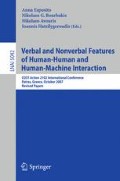Abstract
Expressive speech synthesis representing different human emotions has been in the interests of researchers for a longer time. Recently, some experiments with storytelling speaking style have been performed. This particular speaking style is suitable for applications aimed at children as well as special applications aimed at blind people. Analyzing human storytellers’ speech, we designed a set of prosodic parameters prototypes for converting speech produced by the text-to-speech (TTS) system into storytelling speech. In addition to suprasegmental characteristics (pitch, intensity, and duration) included in these speech prototypes, also information about significant frequencies of spectral envelope and spectral flatness determining degree of voicing was used.
Access this chapter
Tax calculation will be finalised at checkout
Purchases are for personal use only
Preview
Unable to display preview. Download preview PDF.
References
Přibilová, A., Přibil, J.: Non-linear Frequency Scale Mapping for Voice Conversion in Text-to-Speech System with Cepstral Description. Speech Communication 48, 1691–1703 (2006)
Iida, A., Campbell, N., Higuchi, F., Yasumura, M.: A Corpus-Based Speech Synthesis System with Emotion. Speech Communication 40, 161–187 (2003)
Navas, E., Hernáez, I., Luengo, I.: An Objective and Subjective Study of the Role of Semantics and Prosodic Features in Building Corpora for Emotional TTS. IEEE Transactions on Audio, Speech, and Language Processing 14, 1117–1127 (2006)
Tao, J., Kang, Y., Li, A.: Prosody Conversion from Neutral Speech to Emotional Speech. IEEE Transactions on Audio, Speech, and Language Processing 14, 1145–1154 (2006)
Přibil, J., Přibilová, A.: Emotional Style Conversion in the TTS System with Cepstral Description. In: Esposito, A., Faundez-Zanuy, M., Keller, E., Marinaro, M. (eds.) COST Action 2102. LNCS (LNAI), vol. 4775, pp. 65–73. Springer, Heidelberg (2007)
House, D., Bell, L., Gustafson, K., Johansson, L.: Child-Directed Speech Synthesis: Evaluation of Prosodic Variation for an Educational Computer Program. In: Proceedings of Eurospeech, Budapest, pp. 1843–1846 (1999)
Theune, M., Meijs, K., Heylen, D., Ordelman, R.: Generating Expressive Speech for Storytelling Applications. IEEE Transactions on Audio, Speech, and Language Processing 14, 1137–1144 (2006)
Přibil, J., Přibilová, A.: Voicing Transition Frequency Determination for Harmonic Speech Model. In: Proceedings of the 13th International Conference on Systems, Signals and Image Processing, Budapest, pp. 25–28 (2006)
Vích, R.: Cepstral Speech Model, Padé Approximation, Excitation, and Gain Matching in Cepstral Speech Synthesis. In: Proceedings of the 15th Biennial International EURASIP Conference Biosignal, Brno, pp. 77–82 (2000)
Gray, A.H., Markel, J.D.: A Spectral-Flatness Measure for Studying the Autocorrelation Method of Linear Prediction of Speech Analysis. IEEE Transactions on Acoustics, Speech, and Signal Processing ASSP-22, 207–217 (1974)
Esposito, A., Stejskal, V., Smékal, Z., Bourbakis, N.: The Significance of Empty Speech Pauses: Cognitive and Algorithmic Issues. In: Proceedings of the 2nd International Symposium on Brain Vision and Artificial Intelligence, Naples, pp. 542–554 (2007)
Ito, T., Takeda, K., Itakura, F.: Analysis and Recognition of Whispered Speech. Speech Communication 45, 139–152 (2005)
Přibil, J., Madlová, A.: Two Synthesis Methods Based on Cepstral Parameterization. Radioengineering 11(2), 35–39 (2002)
Unser, M.: Splines. A Perfect Fit for Signal and Image Processing. IEEE Signal Processing Magazine 16, 22–38 (1999)
Akande, O.O., Murphy, P.J.: Estimation of the Vocal Tract Transfer Function with Application to Glottal Wave Analysis. Speech Communication 46, 15–36 (2005)
Přibil, J., Přibilová, A.: Distributed Listening Test Program for Synthetic Speech Evaluation. In: Proceedings of the 34 Jahrestagung für Akustik DAGA 2008, Dresden (to be published, 2008)
Author information
Authors and Affiliations
Editor information
Editors and Affiliations
Rights and permissions
Copyright information
© 2008 Springer-Verlag Berlin Heidelberg
About this paper
Cite this paper
Přibil, J., Přibilová, A. (2008). Application of Expressive Speech in TTS System with Cepstral Description. In: Esposito, A., Bourbakis, N.G., Avouris, N., Hatzilygeroudis, I. (eds) Verbal and Nonverbal Features of Human-Human and Human-Machine Interaction. Lecture Notes in Computer Science(), vol 5042. Springer, Berlin, Heidelberg. https://doi.org/10.1007/978-3-540-70872-8_15
Download citation
DOI: https://doi.org/10.1007/978-3-540-70872-8_15
Publisher Name: Springer, Berlin, Heidelberg
Print ISBN: 978-3-540-70871-1
Online ISBN: 978-3-540-70872-8
eBook Packages: Computer ScienceComputer Science (R0)

